Authorisation and monitoring activity
January 2019
Introduction and overview of 2016/17
- We have a statutory responsibility for the education and training of solicitors, as set out in the Solicitors Act 1974 and the Legal Services Act 2007. These education and training requirements play a key part in helping us to protect consumers of legal services. This report concerns our quality assurance activity in relation to education and training. Unless otherwise stated, it relates to the period 1 September 2016 to 31 August 2017.
- During this time, we have continued to develop the Solicitors Qualifying Examination (SQE), which all aspiring solicitors in England and Wales would need to take to qualify. Following extensive consultation, in April 2017 our Board approved proposals for the introduction of the SQE. The Legal Services Board then also approved the proposals. We also appointed Kaplan as the assessment organisation for the SQE in July 2018, after a lengthy tendering process. The SQE will not be introduced before September 2021.
- Between May and July 2017 we consulted on the draft regulations for the new route to qualification and the proposals for the admission of lawyers who are already qualified (other than as solicitors of England and Wales).
- Between September and December 2017 we consulted on the transition between the current routes to qualification described in this report and the new arrangements for the SQE.
- The majority of those who qualify as solicitors will have completed, in this order:
- the academic stage of training – qualifying law degree (QLD) or common professional examination (CPE)
- the vocational stage of training – the legal practice course (LPC), period of recognised training (PRT) and professional skills course (PSC).
- This report analyses the information we receive from the course providers that we approve or authorise to provide courses. It also analyses information we gather on the routes to qualification of those admitted to the profession.
Key findings
- Overall, rates of successful completion for the LPC and CPE remain reasonably constant. We consider successful completion to be where a student has passed the LPC, but students who have not successfully completed may have additional attempts available to them and may have been referred or deferred in one or more than one subject. This means that students may go on to successfully complete the LPC in the future.
- However, there appear to be significant differences in the successful completion rates between providers. There are a number of different factors which may influence pass rates, including candidate ability and engagement, teaching quality and assessment arrangements, but we are unable to draw firm conclusions from the data available.
- In addition to the differences in overall successful completion rates, there are significant differences between providers in the proportion of students who achieve pass, commendation or distinction grades.
- Data indicates that students from ethnic groups other than white students are less likely to successfully complete the CPE and the LPC.
- Male and female students appear to perform equally well on the CPE and LPC and women outnumber men on both courses and at the point of admission.
- Our data on the ethnic origin of those undertaking a PRT is less comprehensive. This is because for the period 2016/17 some 92% of training contracts registered indicated ethnic background as "unknown".
Numbers admitted by route
- Figure 1 sets out the routes to qualification as a solicitor under our existing training regulations. The graduate route takes a minimum of six years for those who study full time and undertake a PRT of two years (full time). Figure 1 also illustrates the routes available to legal executives and lawyers qualified in other jurisdictions.
Figure 1: Pathways to qualification
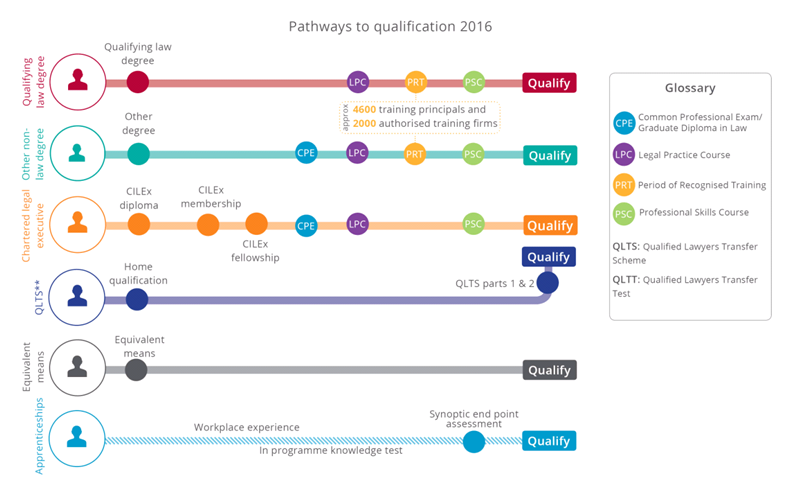
Figure 2: Numbers admitted by route
| 12 months to end of... | LPC | Qualified lawyers transfer test | Qualified lawyers transfer scheme | Chartered Institute of Legal Executive routes | Other | Total |
|---|---|---|---|---|---|---|
| Jun-15 | 5,327 | 89 | 441 | 136 | 35 | 6,028 |
| Jun-16 | 5,420 | 36 | 580 | 239 | 38 | 6,313 |
| Jun-17 | 5,566 | 27 | 673 | 228 | 58 | 6,552 |
- Key findings from this period are:
- some 6,552 solicitors were admitted
- approximately 85% of those admitted followed the route to qualification set out in the SRA Training Regulations 20141
- the qualified lawyers transfer Test (QLTT) and qualified lawyers transfer scheme (QLTS) account for approximately 11% of those admitted.
The QLTT and QLTS qualification routes are taken by barristers of England and Wales and lawyers qualified in other jurisdictions who wish to qualify as solicitors of England and Wales.
The QLTT assessment ceased to be available from 31 August 2010. It was replaced by the QLTS, which is a two-stage assessment of the knowledge and skills needed to be a solicitor. Candidates who have completed the QLTT may still apply for admission as there may be a significant delay between passing the assessment and applying for admission.
Providers of legal education and training
- Course providers range from universities that offer only a QLD to those that offer a full range of pre and post-qualification courses. In 2016/17, all pre-qualification education took place in providers that are also subject to regulation by the Quality Assurance Agency for Higher Education (QAA).
- The PRT takes place in firms and organisations we authorise to provide training. Two providers offer their courses across a number of locations. Six providers offer a programme that combines the QLD and the LPC (the exempting degree).
Legal Practice Course
- When monitoring the quality and standards of education and training, we focus on the two professional qualifications within the framework: the CPE (the academic award is more commonly known as the graduate diploma in law (GDL)) and the LPC.
- For the CPE and the LPC, our monitoring involves an initial approval of the course (CPE) or authorisation (LPC). Each provider must also submit an annual course monitoring report. Our main quality assurance activity is reviewing course providers' reports on the programme they offer. They must submit this information to us, and it must contain qualitative and quantitative data. This is known as the Annual Course Monitoring Report. If there are issues, we have the power to make a monitoring visit to a provider.
- The figures from LPC providers (and which are analysed in detail below) indicate that, overall:
- 7,351 (66% of enrolled students) successfully completed the LPC, compared with 65% last year
- 3.86% failed the LPC in this period
- the remaining students were either withdrawn, suspended, or were referred or deferred from their assessments.2
Figure 3: LPC results by provider

- Successful completion rates by provider vary from below 40% to 100%. In addition to the variation in successful completion rates, there is significant variation between providers in terms of the proportion of students obtaining pass, commendation and distinction grades. It is unclear what the reasons are for such a wide disparity in performance. There are very large differences in the size of the different providers, from a group of 20 students to many thousands of students spread over different locations. There may also be variation in academic ability between different intakes, variable quality of teaching, and/or different approaches to assessment. This makes it difficult to be confident about consistent outcomes.
- The size of LPC provision varies. The largest providers, BPP University and the University of Law, offer the LPC across a number of different locations. Between them, they shared 77% (8,625) of the total number of students enrolled to take assessments (78% in 2015/16). Several providers had fewer than 50 students. The smallest course had 20 students.
Results by gender
- Some 64% of students in this cohort were female and 36% were male. This indicates a marginal change from 2015/16, when 63% of students were female and 37% were male. There is little difference in performance on the LPC by gender, in that over 60% of both male and female candidates successfully completed the LPC. The pass rate for female students was 66% and for male students was 65%. Female students achieved a higher proportion of distinctions but similar rates of both pass and commendation grades.
Figure 4: LPC results by gender
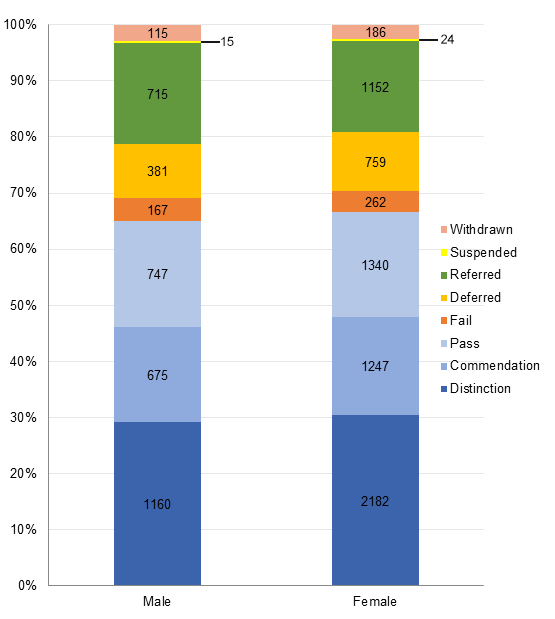
Results by ethnicity
Figure 5: LPC results by ethnicity
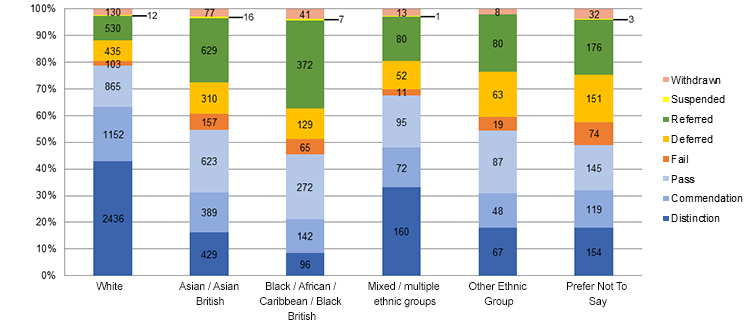
- Key findings show:
- 24% of students identified themselves as Asian/Asian British
- approximately 10% as black/African/Caribbean/black British
- approximately 4% as mixed/multiple ethnic groups.
- The table indicates that students from these ethnic backgrounds are less likely to pass the LPC and more likely to fail or be referred or deferred in their assessments. Almost 80 % of white students successfully completed the LPC in the period in comparison with approximately 55 % of Asian/Asian British students and 45 % of black students. The table indicates both higher 'fail' rates amongst these groups but also significantly higher rates of both referral and deferral.
Results by disability
Figure 6: LPC results by disability
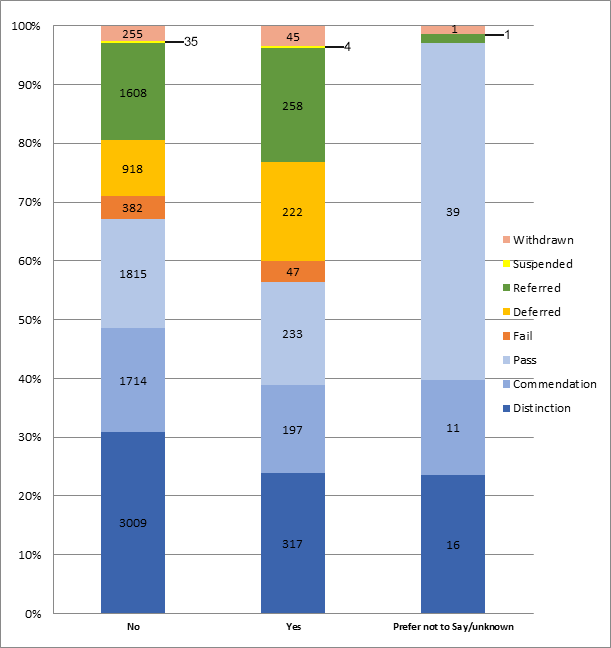
- Figure 6 illustrates comparative performance on the LPC of students with disabilities. Approximately 12% of students identified themselves as having a disability, compared with 11% last year. The responsibility for making reasonable adjustments for students with disabilities is a matter for the LPC provider. However, in some, cases the course provider can seek guidance from us as to whether the proposals for reasonable adjustments are acceptable. However, the numbers identifying themselves as having a disability do not necessarily correlate with the numbers of students for whom reasonable adjustments are made by providers.
- It is apparent from the table that students who have disabilities are more likely than their colleagues who do not have disabilities to be referred or deferred in their assessments. This may reflect the need for students with disabilities to defer their assessments in response to a deterioration in their condition. As indicated previously in this report, students referred or deferred in their assessments will normally have further assessment attempts available to them.
- All LPC providers must submit to us a narrative annual report on their LPC course. In addition, providers appoint external examiners to review the quality and standards of their assessments. Each of the LPC providers appoints its own external examiners and the external examiners report to the LPC provider (rather than to us). In their narrative Annual Course Monitoring Reports, the LPC providers include a summary and analysis of issues raised by the external examiners and the provider's response to those issues. In 2016/17, we asked the LPC providers to send us copies of the external examiners reports with their own narrative reports.
- Although we prescribe a template for the narrative report, there is inconsistency in the amount of information provided. Some providers offer very brief responses, whereas others offer a great deal of information on matters such as the student feedback on the course and the external examiners' reports.
- The external examiners are largely positive about the LPC overall with providers reporting positive comment in relation to:
- marking schemes and moderation processes
- up to date and professional curricula
- fair and effective assessments
- academic standards and programme quality
- learning and teaching strategies and materials.
- Some areas of concern identified were:
- Questions where candidates' answers matched very closely the answer in the marking scheme. The external examiner was concerned that the question may have been very similar to an exercise for which candidates may have been provided with a written answer as part of their course materials.
- Instances where repeated concerns expressed by external examiners had not been addressed by the provider.
- Doubt expressed by an external examiner that strong marks on a module were not necessarily reflective of the understanding of students.
- Whether student achievement was comparable with similar courses or subjects offered by other providers.
- Whether assessments were not comparable to those at other institutions because of factors such as the structure of assessments, the mark allocation and the level of challenge.
- Whether the standard needed to pass assessments was too low to be confident that students were properly equipped to enter the legal workplace.
- Where we have identified issues, we have addressed them with the providers with the aim of resolving them.
- We will continue to review the content of reports and external examiners reports for the future.
Figure 7: CPE/GDL results by provider
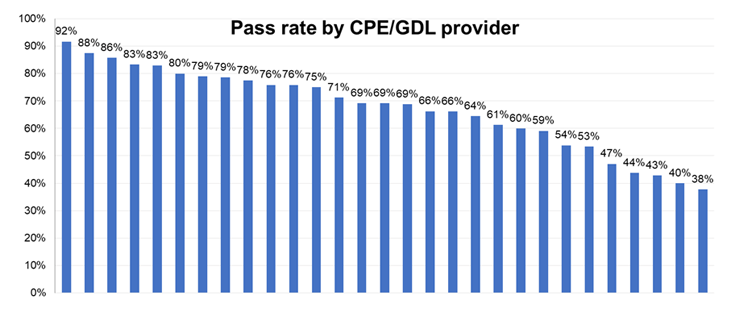
- Figure 7 shows CPE/GDL results. The total number of students who enrolled and were eligible to sit assessments that would enable them to complete the CPE in the period of the report was 5,183 (compared with 4,466 in the previous academic year). This includes:
- full-time students enrolling for the first time in September 2015 (or later)
- part-time students in their second year of study
- students who had referred or deferred assessment attempts.
CPE assessment rules permit three attempts at each assessment. Figure 10 indicates overall outcomes for the CPE/GDL.
- As with the LPC, the CPE/GDL is offered by a range of providers, all of which are also subject to regulation by the Quality Assurance Agency for Higher Education. Student numbers on the course vary considerably. The largest providers, BPP University and the University of Law, offer the CPE across a range of locations. As with the LPC, BPP and the University of Law dominate the market, together accounting for approximately 74% of student recruitment. The smallest student cohort was five students.
- Rates of successful completion of the CPE/GDL by provider shown in figure 7 also vary significantly, from less than 40% to 90%. In addition to the differences in rates of successful completion, it is again apparent that (among those who do successfully complete) there are very significant differences in the proportions obtaining pass, commendation and distinction grades. Once again, it is difficult to draw firm conclusions about the reasons for this. There is significant variation in size of providers. There may also be student cohorts of different academic ability, differences in the quality of teaching and/or in the approach to assessment.
- Providers supply us with a summary and evaluation of issues raised by their external examiners in their Annual Course Monitoring Reports. These did not raise any concerns about quality and standards on the CPE/GDL.
Results by gender
- Figure 8 provides a breakdown of CPE successful completion rates by gender. These numbers indicate comparable performance in the CPE/GDL by gender.
- Of this cohort, 40% of candidates were male and 60% female.
- The successful completion rate for male candidates was 63% and for female candidates 65%. With rounding, the overall successful completion rate was 6
Figure 8: GDL performance by gender
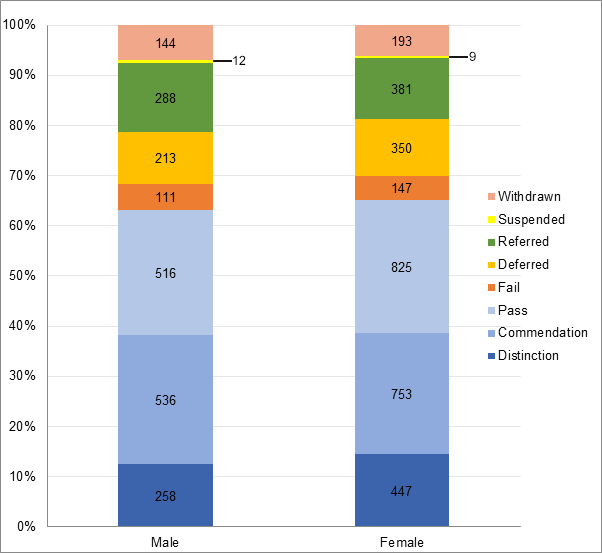
Results by ethnicity
- Figure 9 shows breakdown of CPE completion rates by ethnicity. As with the LPC, these numbers appear to indicate that students from ethnic groups other than white are less likely to pass the CPE/GDL and are more likely to fail or be deferred or referred.
- White students form approximately 59% of the cohort and have a successful completion rate of 74%. Asian/Asian British students account for 17% of the cohort and have a successful completion rate of 52%. Black (African/Caribbean/Black British) form 7% of the cohort and the successful completion rate is 47%. In addition, where white students are successful, they are much more likely to be awarded commendations or distinctions.
Figure 9: GDL performance by ethnicity
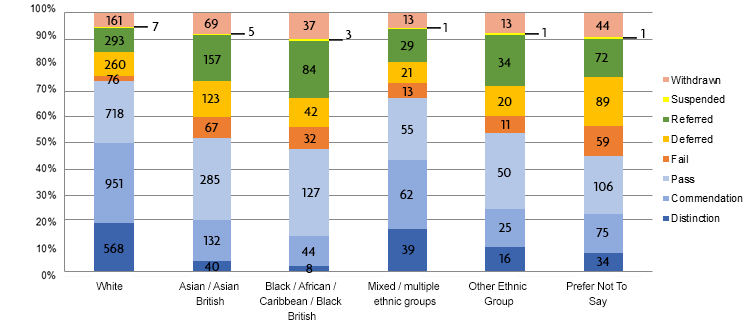
Results by disability
- In this cohort of students, some 10.5% declared a disability (although this is unlikely to reflect the proportion of students having special arrangements for learning and assessment).
- The successful completion rate for students declaring a disability was 58% in comparison with 65% for students who did not declare a disability. Students declaring a disability have higher rates of withdrawal from the course, referral for resit and deferral of assessment.
Figure 10: GDL performance by disability
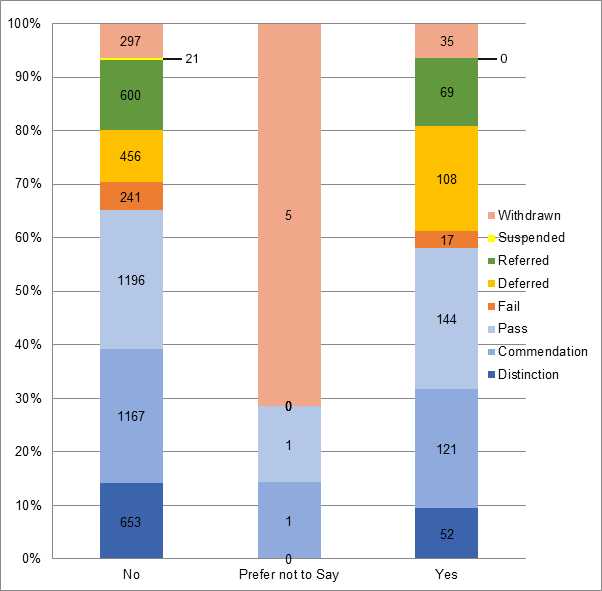
- The final stage of qualification pathway is a PRT (trainees will also need to undertake the PSC). Training will take place in a firm or organisation approved by us to take trainees and, if carried out on a full-time basis, will usually be for a period of two years.
- The tables in figure 14 provide details of the number of training contracts registered with us in the last three periods 2014/15, 2015/16 and 2016/17.
Periods of recognised training
Figure 11: PRT age band breakdown
| Age band | 2014/15 | 2015/16 | 2016/17 | |||
|---|---|---|---|---|---|---|
| 18-21 | 31 | 0.50% | 52 | 0.90% | 42 | 0.70% |
| 22-25 | 3,279 | 56.20% | 3,422 | 57.70% | 3,392 | 57.30% |
| 26-30 | 1,893 | 32.50% | 1,821 | 30.70% | 1,884 | 31.80% |
| 31-35 | 369 | 6.30% | 377 | 6.40% | 318 | 5.40% |
| 36-40 | 119 | 2.00% | 144 | 2.40% | 142 | 2.40% |
| 41-45 | 77 | 1.30% | 62 | 1.00% | 70 | 1.20% |
| 46-50 | 37 | 0.60% | 33 | 0.60% | 46 | 0.80% |
| 51-55 | 20 | 0.30% | 13 | 0.20% | 9 | 0.20% |
| 56-60 | 5 | 0.10% | 3 | 0.10% | 10 | 0.20% |
| 61+ | 1 | 0.00% | 1 | 0.00% | 4 | 0.10% |
| Unknown | 0 | 0.00% | 1 | 0.00% | 6 | 0.10% |
| Total | 5,831 | 100% | 5,929 | 100% | 5,923 | 100% |
Figure 12: PRT ethnicity breakdown
| Ethnicity | 2014/15 | 2015/16 | 2016/17 |
|---|---|---|---|
| BAME | 505 | 344 | 254 |
| Asian | 343 | 228 | 167 |
| Black | 77 | 48 | 45 |
| Chinese | 21 | 14 | 9 |
| Mixed | 40 | 42 | 19 |
| Other | 24 | 12 | 14 |
| White | 832 | 451 | 244 |
| Unknown | 4,494 | 5,134 | 5,425 |
| Total | 5,831 | 5,929 | 5,923 |
- Our information in respect of the ethnicity of those in periods of recognised training is incomplete because of the large numbers where ethnicity is recorded as "unknown".
Figure 13: PRT Disability breakdown
| Disability | 2014/15 | 2015/16 | 2016/17 |
|---|---|---|---|
| Physical | 0 | 2 | 0 |
| Mental | 0 | 0 | 0 |
| Learning | 4 | 3 | 3 |
| Sensory | 0 | 0 | 0 |
| Hearing | 1 | 2 | 0 |
| Visual | 1 | 0 | 0 |
| Long standing illness | 2 | 1 | 1 |
| other | 2 | 0 | 0 |
In the period 2016/17, nine individuals indicated that they had a disability. Four of these gave further information concerning the type of disability.
Figure 14: PRT Gender breakdown
| Gender | 2014/15 | 2015/16 | 2016/17 |
|---|---|---|---|
| Female | 3,669 | 3,698 | 3,774 |
| Male | 2,162 | 2,231 | 2,149 |
| Total | 5,831 | 5,929 | 5,923 |
- This data indicates that firms and organisations are recruiting more female than male trainees.
- Some 673 barristers and lawyers qualified via this route. Individuals are able to qualify through this route if they are a qualified lawyer in a jurisdiction that we recognise and complete the QLTS assessments. The QLTS assesses an individual's competence by way of multiple-choice testing (MCT) of legal knowledge and skills-based assessments, called objective structured clinical examination (OSCE). Candidates must pass the MCT (stage 1) before being able to progress to the OSCE (stage 2). The assessments are operated by Kaplan and the MCT assessment is offered at multiple centres around the world. The OSCE assessments take place in London.
- During this period, 1,790 candidates attempted the MCT assessment and 872 candidates attempted the OSCE.
- The pass rates in percentages from the total number of candidates achieved by candidates in different groups are overleaf.
Figure 15: QLTS results data (calendar year 2017)
| Assessment | Number of candidates | Gender | ||
|---|---|---|---|---|
| Male | Female | Not stated | ||
| MCT | 1,790 | 50.4% (851) | 51.5% (922) | 17 |
| OSCE | 872 | 58.1% (427) | 65.4% (431) | 14 |
| Assessment | Number of candidates | Ethics group | ||
|---|---|---|---|---|
| BME | White | Not stated | ||
| MCT | 1,790 | 41.7% (900) | 62.0% (682) | 208 |
| OSCE | 872 | 54.0% (352) | 69.5% (377) | 143 |
| Assessment | Number of Candidates | First language English | ||
|---|---|---|---|---|
| Yes | No | Not stated | ||
| MCT | 1,790 | 57.4% (895) | 44.7% (895) | 0 |
| OSCE | 872 | 72.0% (472) | 50.2% (400) | 0 |
| Assessment | Number of Candidates | Candidates declaring a Disability | ||
|---|---|---|---|---|
| Yes | No | Not stated | ||
| MCT | 1,790 | 57.1% (14) | 51.0% (1,776) | 0 |
| OSCE | 872 | 37.5% (16) | 62.5% (856) | 0 |
- The information in figure 15 is for the period January 2017–December 2017.
- Candidates from 88 jurisdictions took assessments (either the MCT or the OSCE) in 2017. We currently recognise more than 170 jurisdictions, which include, as separate jurisdictions, the states of America and territories of Canada.
- Some 50.4% of male candidates and 51.5% of female candidates who presented for stage 1 MCT assessment in this period were successful and eligible to progress to stage 2.
- The pass rate for the OSCE was 58.1% for male candidates and 65.4% for female candidates.
- Pass rates by gender, ethnicity and first language are shown in figure 15. Fewer than 20 candidates disclosed a disability.
- The results indicate that the pass rate on the MCT for white students is 62%. For black and minority ethnic students it is 41.7% (a difference of 20.3%). We also have information about the first language of candidates. The pass rate on the MCT for students for whom English is their first language is 57.4%, whereas for those for whom English is not their first language the pass rate is 44.7 %.
- Once students have passed the MCT, however, the discrepancy in performance by ethnic group/first language reduces in the OSCE. the pass rate is 69.5% for white students, 55% for black and minority ethnic students (a difference of 14.5%). The pass rate in the OSCE is 72% for those whose first language is English and 50.2% for those whose first language is not English.
- Since the introduction of the SRA Training Regulations 2014, applicants have been able to meet the academic or vocational requirements of training by an Equivalent Means application.
- We may recognise previous learning and grant exemptions where:
- the level, standard, volume and content of previous learning is equivalent to all or part of a particular stage of education and training
- there is relevant, sufficient and adequate evidence of this learning
- We may also grant exemptions based on work-based experience and the achievement derived from that experience. This is because we recognise the achievement of learning and the subsequent outcomes, not the evidence that an applicant has had experience of doing something.
- Although numbers are still relatively low, they have been steadily increasing. Figure 16 shows that 223 individuals are now eligible for admission as solicitors.
- This is following our assessment of their workplace experience and/or qualifications, considering them equivalent to a formal training contract.
- Figure 16 shows the number of Equivalent Means applications for the period from 1 July 2014 to 30 August 2018.
- The Equivalent Means application will continue to be available during the transition period following the introduction of the SQE.
Figure 16: Number of Equivalent Means applications July 2014–August 2018
| Equivalent Means applications 01.07.2014 to 16.08.18 | Received | Granted | Refused | Withdrawn | Work in progress |
|---|---|---|---|---|---|
| CPE | 212 | 109 | 57 | 33 | 13 |
| CPE for non- graduates | 58 | 40 | 5 | 11 | 2 |
| LPC | 32 | 14 | 5 | 9 | 4 |
| PRT | 351 | 223 | 37 | 42 | 49 |
| PSC | 16 | 5 | 1 | 9 | 1 |
| Morgenbesser | 16 | 4 partially granted3 | 4 | 7 | 1 |
- The SRA Training Regulations 2014 – Qualification and Provider Regulations require the completion of the academic stage of training and the vocational stage of training.
In this context "referred" means students who have failed one or more assessments and may re-sit, and "deferred" means students who have postponed their assessments (eg because of exceptional circumstances such as illness or bereavement).
2 granted equivalence to the academic stage only and 2 granted equivalence to academic stage and the LPC only
